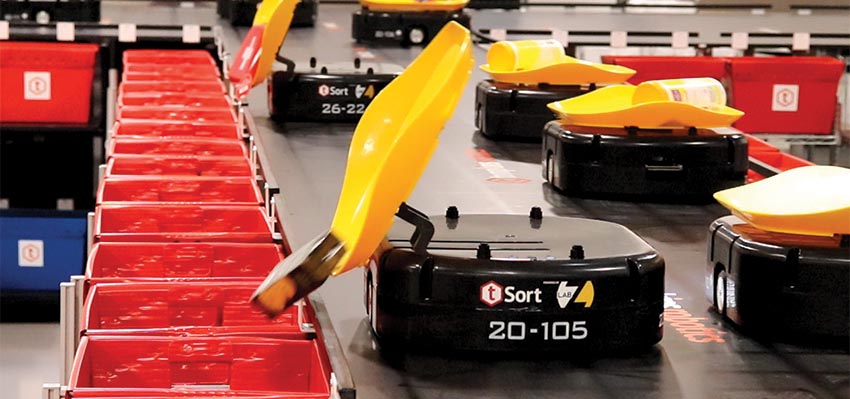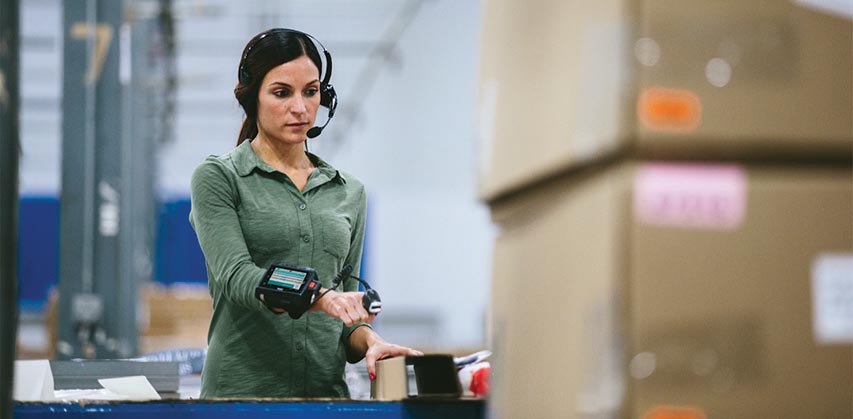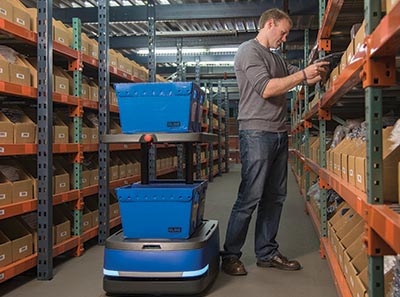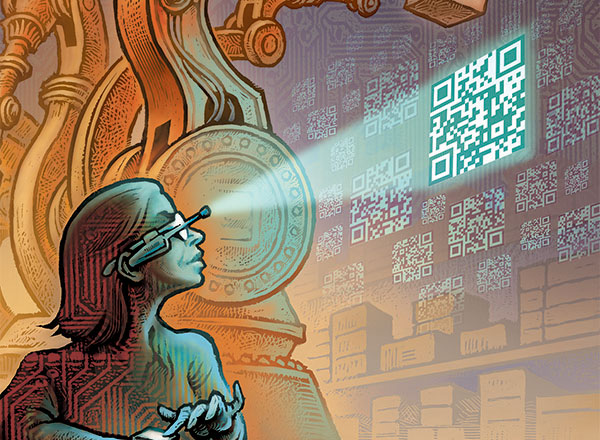John Hill knows a thing or two about technology innovation. In a career that spans 50 years, Hill was at the forefront of the development of industrial applications for bar code scanning and radio frequency identification and the first warehouse management software systems. There’s a reason he remembers that the first implementation of bar code scanning outside of point of sale in grocery and retail was in October 1971 at Buick’s Plant 10. “I carried the 50-pound scanner into Buick to give them the demonstration,” Hill recalls.
Hill has not rested on his laurels. Still a director at St. Onge, he recently attended a conference on automatic identification that brought together more than 400 experts to Google’s headquarters in Sunnyvale, Calif. When he looks at the new mechanical and technology solutions coming to market, he sees the seeds planted back in the 1970s and 1980s now bearing fruit.
“We’ve finally come to where we all thought in our naivete that we’d be by around 1980,” Hill says. “Nothing we’re doing today, even artificial intelligence, belies what we thought we could do more than 40 years ago. It’s just that we didn’t have the tools then that we have today.”

A ping pong table in a Tompkins’ engineer’s garage was the inspiration for a robotic sortation solution for use in e-commerce fulfillment and, potentially, in the backrooms of retail stores.
So just what is materials handling innovation? And, how does the industry capture the lightning in a bottle associated with innovators like Apple and Google? Those were questions we first asked in the May 2017 issue. We set out to define just what innovation means to our industry along with how it is approached at some of the leading OEM and system solution providers, including Swisslog, Toyota Material Handling, Dematic, Honeywell Intelligrated and Knapp Logistics Automation. (You can read “Materials Handling Innovation (And Why It Matters)”).
This year, on the heels of Modex, we thought we’d revisit the topic. But instead of focusing on the household names in automation, we asked six companies playing in the software or technology space, including several startups and smaller players, just what innovation means to their organizations. Here’s what we learned.
From linear to exponential innovation
If you’ve ever seen any of the Farmers Insurance commercials, you know the punch line: “We know a thing or two because we’ve seen a thing or two.” Like John Hill, the same can be said of Jim Tompkins, the chair and CEO of Tompkins International as well as several startups springing from the Tompkins organization. They include a third-party logistics (3PL) provider for e-commerce fulfillment, a robotics company and a sensor-based organization to develop the connected warehouse.
Tompkins defines two types of innovation: Linear and exponential. “Linear innovation is just maintaining the pace of where we’re at,” he says, which would include improvements to existing solutions and technologies. “To do true innovation that results in exponential innovation, you have to move the pace of innovation.”
To make that happen, he adds, requires a need in the market, competent people and resources. To that end, Tompkins created a 12-member innovation team that meets on a regular basis to ask: What is a need that has to be filled? He also created an innovation fund so competent people would have the resources available to explore solutions that might fill the need.
An example of innovation in action is the evolution of a robotic shipping sorter technology that Tompkins licensed from China. “We could’ve made modifications to it, which would have been linear, but instead, we created software that turned it into a unit sorter that allows us to do a batch pick, sort and pack orders and then put it back on the same equipment to sort it to shipping,” Tompkins says. “That’s exponential.” The next step was to put it on a portable platform that could be folded up and stored out of the way at the end of a shift, say in a big box retailer’s backroom. The inspiration came from a ping pong table in one of Tompkins’ engineer’s garage. “The need,” he says, “was to make a portable solution that could be rapidly deployed.”
Some solutions will be ahead of the market, Tompkins concedes. “When I had the first meeting with the innovation team, I said this is not a consulting project,” he recalls. “Our task is to read things that aren’t yet on the page. We’re going to fix problems that the client hasn’t seen yet.”
Change from the top down
Sometimes, you can teach an old dog a new trick. Zebra Technologies and JDA are long-standing organizations in what might be considered mature technologies: Automatic identification and printing at Zebra, and warehouse and supply chain management and execution software solutions at JDA.
At the same time, those technologies are at the intersection of established solutions and the next-generation tools that are going to define tomorrow’s supply chains, such as sensors, artificial intelligence (AI), Big Data, the Internet of Things and Cloud computing. So, how are they responding? In both cases, a look to the future is being driven from the top down.
“Our CEO doesn’t talk about us being a printer company but as being in the enterprise asset intelligence space,” says Mark Wheeler, Zebra’s director of supply chain solutions. “Our role is evolving from being transactional to analytical: Instead of being a system of record for what happened in the warehouse, we’re becoming a system of reality for where a lift truck, person and order are in real time. We’re looking at what’s going on in the warehouse and asking how that can be rethought with sensor technology to gain economic value.”
Something similar is in motion at JDA, according to Steve Simmerman, senior alliance director, who says that innovation is a key initiative from the CEO. “When he came in, he said our customers are demanding innovative solutions,” says Simmerman. “We understand the physical movement of goods. So, now, how can we use machine learning, IoT and artificial intelligence to make those systems more efficient?” For example, how can planning systems use social media news events and weather data to create action plans for when an event like Hurricane Harvey is about to strike?
Both companies have created teams dedicated to innovation separate from traditional R&D: Zebra has a team working on Intelligent Edge Solutions that is driving the change from transactional to analytical and JDA created an innovation center in Montreal where data scientists are tasked with pure R&D as well as working with customers to develop point solutions that might then be folded into JDA’s suite of products.
“In three to five years, I really believe we’re going to see changes in the physical infrastructure and software managing DCs that no one has imagined,” says Simmerman.

Zebra Technologies is looking at how the data collected by its conventional systems can now be used to connect assets across the enterprise.
Applying AI to WMS
Last year, we featured Lodge Manufacturing’s new distribution center in Tennessee. While it was a conventional DC in many respects, relying on lift trucks and pallet and shelf storage, one technology stood out: a Cloud-based, iOS native warehouse management system (WMS) from EVS that used artificial intelligence and machine learning to optimize processes and deliver tasks to an associate’s iPhone.
The combination of Cloud-based computing, AI and an Apple operating system struck us as innovative at the time. What then, we wondered, does that term mean to Evan Garber, the CEO of EVS? “My phrase is that the supply chain starts with the warehouse,” says Garber. “If the velocity of inventory going in and out of your warehouse slows down, your supply chain slows down. If the warehouse can up its game, then the whole supply chain gets better.”
Like Zebra and JDA, EVS has one team working on product development and support, and a second “Black Ops” team comprised of people whose job is to figure out where EVS should go next. “They work on prototypes and when they get to a certain percentage complete, we’ll float trial balloons to analysts like Garter or our customers for feedback,” Garber says. “If they resonate, we bring them into the normal product development cycle.”
Garber’s team also looks at ideas they have developed for one industry, such as the company’s roots in the food industry, and ask how they can be applied to other markets. As for AI, Garber says the WMS provider is looking at issues such as why a stock out occurred to prevent it from happening again in the future. “If an associate is supposed to pick 100 items at Bin A and there are only 90 items there, the WMS would just send the associate to another bin,” Garber says. “But what if we could also ask the system who was around that bin space in the last two days? Who touched it? Did someone grab it and move it somewhere else? If so, is there something we can learn from that? We’re looking for relationships that aren’t visible to the naked eye or in reports to see if the system can make these kinds of links.”
Startup innovation
 In some respects, you could argue that startups, or firms bringing technologies such as robotics and smart glass vision systems to a new market like distribution are by definition innovative. How then do two startups approach innovation?
In some respects, you could argue that startups, or firms bringing technologies such as robotics and smart glass vision systems to a new market like distribution are by definition innovative. How then do two startups approach innovation?
Jerome Dubois, co-founder and co-CEO of 6 River Systems, a Massachusetts-based mobile collaborative robotics company, says his approach is the result of the lessons learned when he worked at Kiva Systems before the company was sold to Amazon in 2012.
“When we founded the company in 2015, we decided that innovation means nothing unless it brings value to the customer,” Dubois says. “So, we asked: What’s the application that can be improved in the warehouse and that was pick-to-cart? Ultimately, our ah-ha moment was that it’s really a labor and a training issue. We decided not to go after the picking arm and replace the human, but create a solution that integrates the transport vehicle, the scanner, the WMS system, put-to-light and conveyor into one system that leads the picker through the warehouse.” He adds that in a 60-person company bringing a technology into a new space, “if you’re not innovating, you’re not doing your job. Our focus is innovating from the customer’s viewpoint.”
In March of this year, we featured DHL Supply Chain’s initiative to bring new technologies into its e-commerce fulfillment operations. Along with robots from Locus Robotics and 6 River Systems, DHL was also using smart glasses and augmented reality from Vuzix for a pick-to-cart application. According to Lance Anderson, the vice president of sales and marketing at Vuzix and a veteran of traditional solution providers, one of the challenges to smart glass technology is that it is an evolving technology. “The materials handling industry can be antiquated—once you get a solution work, you don’t want to touch it,” says Anderson. “Into that environment, we’re bringing something that is just fluid. We’ve been most successful with companies whose cultures embrace that kind of disruption.”
In a sense, the niche for smart glasses is developing along with the technology. Early wins have been in maintenance because of the ability of a technician to remotely connect with a supervisor or engineer. Anderson now sees possibilities in 3PLs like DHL that have traditionally eschewed technology, and small warehouses that can’t afford a pick-to-light system or hardware bolted to the floor.
“Even if smart glasses don’t improve the speed of conventional operations, you now get a digital record of what an associate is doing and, if you have more than one facility, you can tie your smaller DC’s into your bigger warehouses,” he says. Anderson adds that last year, the question from customers was: What is the ROI? This year, they’re asking about the change management required to roll the technology out. That’s progress.
Internally, Anderson says, Vuzix has a five-year technical roadmap that is designed around the idea of change. A multi-discipline team at the director level and above meets regularly to discuss feedback coming in from the field along with macro-economic changes, such as whether a large competitor like Apple or Zebra has come out with something new. “We want to be sure we’re focused in the right direction so we’re not putting time and effort into something world doesn’t want,” he says.
Companies mentioned in this article:
Article topics







